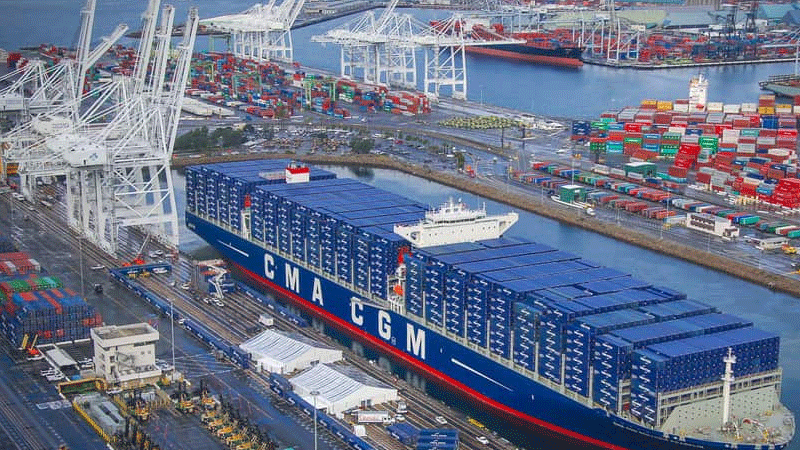The nation’s busiest container port moved 9.2 million Twenty-Foot Equivalent Units (TEUs) in 2020, Port of Los Angeles Executive Director Gene Seroka announced at the Pacific Merchant Shipping Association’s sixth annual State of the Port of Los Angeles – a virtual event this year. A late-year surge of pandemic-induced consumer spending helped boost volumes to near 2019 levels, making 2020 the fourth highest-volume year in the Port’s history.
“Our container business in 2020 was the most erratic we have ever seen, with volumes plunging nearly 19% in the first five months of the year, followed by an unprecedented second-half surge,” Seroka said. “Our ILWU longshore workforce did a great job adapting to the huge swings in volume, as did port truckers and everyone else involved in moving cargo through our Port. In a year of great difficulty, we are extremely grateful for the tenacity and resolve of all of our partners.”
“Los Angeles is one of the world’s great centers of trade and commerce, and that’s because of our port,” said Los Angeles Mayor Eric Garcetti, who delivered a pre-taped video message during the event. “Our success is a credit to the cargo owners who place their trust in us, and to the tireless efforts of our longshore workers, our terminal operators, our truck drivers, and all the essential workers across the supply chain who keep our economy moving even in the toughest of times.”
"In spite of a global pandemic, the Port of Los Angeles -- the number one container port in the country -- remains competitive, efficient, and committed to responsible growth," said Los Angeles Councilmember Joe Buscaino. "The Port is a true partner to the Harbor communities, investing one billion dollars into waterfront infrastructure that will transform the Wilmington and San Pedro waterfronts. The Port is also committed to improving our air quality, expanding security, and securing the latest technologies to ensure that the Port retains its position as the number one container port in America."
The Port’s third- and fourth-quarter 2020 cargo volumes increased 50% over the first half of the year, with the Port handling a remarkable 94% more traffic the week before Christmas than the same week in 2019. The Port completed the year down approximately 1.5% compared to 2019 cargo volumes.
During his speech, Seroka laid out the Port’s priorities for 2021, including job creation, cargo growth, infrastructure investment, accelerating zero emission technology development and deployment, and continued development of a thriving waterfront community. He reiterated the Port’s focus on supply chain efficiency and optimization, calling for nationwide port data connectivity that could provide enhanced visibility, efficiency and choice for cargo owners, as well as a more stable supply chain.
“If we want America to improve as a leader in global trade, we need nationwide port data connectivity with agreed-upon data standards and open architecture system that provides interconnectivity between major U.S. ports, service providers and the freight they move,” said Seroka.
In his call for further supply chain digitization, Seroka announced the development of The Control Tower, the newest in a series of Port Optimizer™ cloud-based data solutions. The Control Tower, developed in collaboration with Wabtec, will provide new levels of metrics and data including real-time port level views of turn times, truck capacity management information and detailed velocity metrics.
The Control Tower will follow the Port’s introduction of The Signal in 2020, a data dashboard providing a three-week-in-advance look at cargo coming into the Port. Later in the year, the port introduced The Return Signal, another real-time data tool helping truckers know when and where to return empty containers to terminals. The Signal and Return Signal are both provided as services of the Port of Los Angeles.
Drayage improvement incentives announced
Seroka noted several challenges faced by the Port in 2020 amidst the pandemic, including drayage truck inefficiencies caused by container volume surges. Drayage trucks currently handle about three-quarters of all import and export containers moving through the Port. In response, Seroka announced a new Truck Turn-Time and Dual-Transaction Incentive Program. Starting in February, the program will financially reward terminal operators who move containerized cargo faster and more efficiently through their terminals.
Crisis Response
The State of the Port address highlighted several Port achievements during 2020, including its leadership of Logistics Victory Los Angeles (LoVLA), which was formed to support procurement of Personal Protective Equipment (PPE) for the City’s stockpile and distribution to frontline workers during the COVID-19 health crisis. To date, the effort -- led by Seroka as the City’s Chief Logistics Officer during this crisis -- has provided more than 4.6 million units of PPE and other supplies to three dozen area hospitals and more than 150 skilled nursing facilities throughout the region.
Infrastructure Investment
Despite the pandemic, Seroka noted the progress on $473 million in Port capital projects, which include eight major terminal, rail and roadway improvements. The Port also moved forward on its goal of zero-emission terminal equipment by 2030 and a zero-emissions drayage fleet by 2035. It currently has 16 demonstration projects underway involving the testing of 134 pieces of advanced equipment, including 78 zero-emissions trucks.
The Port remains committed to the development of the LA Waterfront, with Seroka adding that the Port broke ground on the nine-acre, $71 million Wilmington Waterfront Promenade, the $33 million San Pedro Town Square at Harbor Boulevard and Sixth Street and the nearly mile-long walkway along the Main Channel. This will lead to the $150 million West Harbor commercial retail and entertainment center, scheduled to break ground this year with a Phase 1 opening in late 2022.
The Port of Los Angeles remains open with all terminals operational during the COVID-19 pandemic. North America’s leading seaport by container volume and cargo value, the Port of Los Angeles facilitated $276 billion in trade during 2019. San Pedro Bay port complex operations and commerce facilitate one in nine jobs across the counties of Los Angeles, Orange, Riverside, San Bernardino and Ventura.









